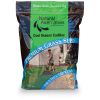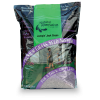Every lawn faces seasonal challenges. Depending on weather, local conditions and maintenance, your lawn may encounter one of many damaging turfgrass diseases. From brown patch to leaf spot, these diseases can harm the health and appearance of your lawn, and should be addressed as soon as possible. Preventing lawn diseases with proper cultural practices before they occur is key.
The foundation to a healthy lawn lies in proper mowing and watering regimens. Mow when the grass is high. Repeatedly mowing a lawn too short leads to a less robust root system, decreasing the amount of water and nutrients turf can absorb. In turn, this deficient diet leaves a lawn unprepared to combat always-present pathogens, leading to a susceptible plant ready for disease infection. Similarly, watering a lawn too frequently can lead to a perpetually moist environment perfect for molds and other bacterial growths. Water the lawn infrequently but deeply to promote proper root development while allowing the turf to dry out between watering.
Lawns with heavy shade may be more susceptible to infection, especially in moist environments. It is particularly important to not overwater shady regions, as a lack of consistent sunlight prevents turf from drying out. A higher level of sustained humidity without sunlight can easily promote lawn disease. When watering shady areas, try to do so in the early to mid-morning to allow maximum drying time throughout the day.
Removing lawn litter, such as leaf piles and fallen branches, can help prevent diseases from taking hold. Dense leaf and debris piles can act as incubators for moisture and disease, preventing turf from receiving sufficient sunlight and airflow.
If you’ve noticed a possible disease on your lawn, attempt to identify potential causes. Diseases like dollar spot and brown patch tend to appear when local air humidity has been consistently high. Consistent drought can lead to Ascochyta leaf blight and stripe smut. Typically, less than optimal conditions can be identified as the cause for a new disease cropping up in a lawn.
If you’re able to identify the disease, attempt to improve the lawn environment to prevent the disease from spreading. If overly moist natural conditions are allowing disease to spread, remove obstructions blocking sunlight and proper airflow to turf. Excessively low-hanging tree branches, debris piles and tents or canopies can all promote shade and prevent turf from drying out sufficiently. If overly dry conditions are leading to visible damage, increase the amount of watering you provide your lawn while abiding by any local drought regulations.
When lawn diseases present themselves, improved cultural practices and attentive maintenance can typically rectify the issue over time. When dealing with some aggressive cases, it may be necessary to introduce fresh, disease resistant grass seed to your lawn to replace damaged areas. For cool season lawns like fescue blends and ryegrass, seed in the fall for best results. Warm season lawns such as Bermudagrass and zoysiagrass should be sprigged by transplanting plugs from healthy sections of lawn to promote new growth in affected areas.
For more healthy lawn care tips, sign up for the Natural Alternative® e-newsletter, The Monthly Dirt.



